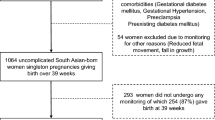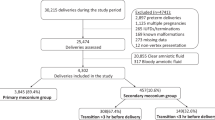Abstract
OBJECTIVE: To determine whether an antepartum amniotic fluid index (AFI) of 5.0 cm or less is a predictor of adverse perinatal outcome.
STUDY DESIGN: The antepartum testing records of 779 women seen over a 12-month period were reviewed. Data, including the reasons for testing, the testing results, and pregnancy outcome were abstracted from these records. Inclusion criteria included a nonanomalous fetus and delivery within 7 days of the last antepartum surveillance test (modified biophysical profile). Chi-square analysis, Fisher's exact test, t tests and receiver-operator curves (ROCs) were used for analysis.
RESULTS: An AFI of 5.0 cm or less was significantly associated with an abnormal antepartum fetal heart rate (FHR) tracing but not with cesarean delivery, meconium-stained fluid, Apgars less than 7, or NICU admission. Subjects with an AFI of 5.0 cm or less had a higher rate of cesarean for fetal distress, but this did not reach statistical significance. ROCs produced no diagnostic cutoff values for AFI or largest pocket and prediction of any of the chosen parameters.
CONCLUSIONS: Antepartum oligohydramnios is associated with an increased risk of fetal heart rate abnormalities. Although in our population it is not predictive of adverse perinatal outcome as measured by low Apgars and NICU admissions, this may be reflective of the aggressive antepartum and intrapartum management that these patients received.
This is a preview of subscription content, access via your institution
Access options
Subscribe to this journal
Receive 12 print issues and online access
$259.00 per year
only $21.58 per issue
Buy this article
- Purchase on Springer Link
- Instant access to full article PDF
Prices may be subject to local taxes which are calculated during checkout


Similar content being viewed by others
References
Manning FA, Platt LD, Sipos L . Antepartum fetal evaluation: development of a fetal biophysical profile Am J Obstet Gynecol 1980 136: 787–95
Manning FA, Hill LM, Platt LD . Qualitative amniotic fluid volume determination by ultrasound: antepartum detection of intrauterine growth retardation Am J Obstet Gynecol 1981 139: 254–8
Philipson EH, Sokol RJ, Williams T . Oligohydramnios: clinical association and predictive value for intrauterine growth retardation Am J Obstet Gynecol 1983 146: 271–6
Crowley P . Non-quantitative estimation of amniotic fluid volume in suspected prolonged pregnancy J Perinat Med 1980 8: 249–51
Phelan JP, Platt LD, Yeh S-Y, Broussard P, Paul RH . The role of ultrasound assessment of amniotic fluid volume in the management of the postdate pregnancy Am J Obstet Gynecol 1985 151: 304–8
Divon MY, Marks AD, Henderson C . Longitudinal measurement of amniotic fluid index in postterm pregnancies and its association with fetal outcome Am J Obstet Gynecol 1995 172: 142–6
Rutherford SE, Phelan JP, Smith CV, Jacobs N . The four-quadrant assessment of amniotic fluid volume: an adjunct to antepartum fetal heart rate testing Obstet Gynecol 1987 70: 353–6
Phelan JP, Smith CV, Broussard P, Small M . Amniotic fluid volume assessment using the four-quadrant technique in the pregnancy at 36–42 weeks gestation J Reprod Med 1997 32: 540–2
Grubb DK, Paul RH . Amniotic fluid index and prolonged antepartum fetal heart rate decelerations Obstet Gynecol 1992 79: 558–60
Sarno AP, Ahn MO, Phelan JP . Intrapartum amniotic fluid volume at term: association of ruptured membranes, oligohydramnios, and increased fetal risk J Reprod Med 1990 35: 719–23
Chauhan SP, Cowan BD, Magann EF et al. Intrapartum amniotic fluid index: a poor diagnostic test for adverse perinatal outcome J Reprod Med 1996 41: 860–6
Chauhan SP, Magann EF, Perry KG, Morrison JC . Intrapartum amniotic fluid index and two-diameter pocket are poor predictors of adverse neonatal outcome J Perinat 1997 17: 221–4
Hanley JA, McNeil BJ . The meaning and use of the area under a receiver operating characteristic (ROC) curve Radiology 1982 143: 29–36
Banks EH, Miller DA . Perinatal risks associated with borderline amniotic fluid index Am J Obstet Gynecol 1999 180: 1461–3
Magann EF, Chauhan SP, Kinsella MJ, McNamara MF, Whitworth NS, Morrison JC . Antenatal testing among 1001 patients at high risk: the role of ultrasonographic estimate of amniotic fluid volume Am J Obstet Gynecol 1999 180: 1330–4
Chauhan SP, Magann EF, Morrison JC, Whitworth NS, Hendrix NW, Devoe LD . Ultrasonic assessment of amniotic fluid does not reflect actual amniotic fluid volume Am J Obstet Gynecol 1997 177: 291–7
Magann EF, Nolan TE, Hess LW, Martin RW, Whitworth NS, Morrison JC . Measurement of amniotic fluid volume: accuracy of ultrasonography techniques Am J Obstet Gynecol 1992 167: 1533–7
Horsager R, Nathan L, Leveno KJ . Correlation of measured amniotic fluid volume and sonographic predictions of oligohydramnios Obstet Gynecol 1994 83: 955–8
Boehm FH, Salyer S, Shah DM, Vaughn WK . Improved outcome of twice weekly nonstress testing Obstet Gynecol 1986 67: 566–8
Author information
Authors and Affiliations
Additional information
Presented at the 19th Annual Meeting for the Society for Maternal–Fetal Medicine 1999 in San Francisco, California.
Rights and permissions
About this article
Cite this article
Voxman, E., Tran, S. & Wing, D. Low Amniotic Fluid Index as a Predictor of Adverse Perinatal Outcome. J Perinatol 22, 282–285 (2002). https://doi.org/10.1038/sj.jp.7210697
Published:
Issue Date:
DOI: https://doi.org/10.1038/sj.jp.7210697
This article is cited by
-
Oligohydramnios: a prospective study of fetal, neonatal and maternal outcomes in low-middle income countries
Reproductive Health (2020)
-
Oligoamnios and Perinatal Outcome
The Journal of Obstetrics and Gynecology of India (2017)
-
Intra-vaginal prostaglandin E2 versus double-balloon catheter for labor induction in term oligohydramnios
Journal of Perinatology (2015)
-
Low Amniotic Fluid Index at Term as a Predictor of Adverse Perinatal Outcome
The Journal of Obstetrics and Gynecology of India (2014)
-
Correlation of Amniotic Fluid Index with Perinatal Outcome
The Journal of Obstetrics and Gynecology of India (2014)



